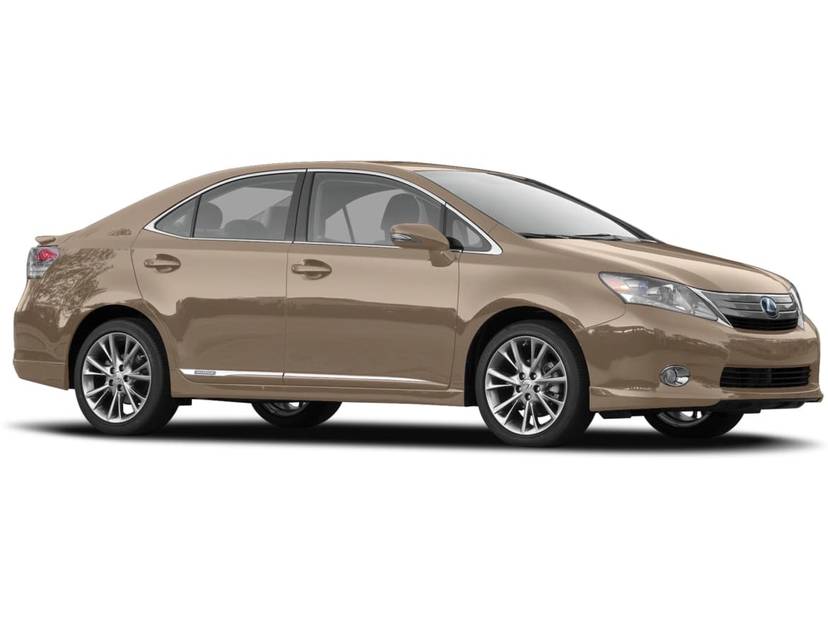
Lexus’ new HS 250h is a refined hybrid luxury sedan that delivers plenty of power when you need it and features a high-quality interior. In terms of efficiency, its EPA-estimated gas mileage of 35/34 mpg city/highway vaults it to the head of Lexus’ lineup, as well as near the top of the luxury segment.
That’s all well and good, but many eco-conscious shoppers will compare the HS 250h’s gas mileage and price tag to the more mainstream Toyota Prius, which costs roughly $13,000 less and goes 15 miles further on every gallon of gas. There’s no question the HS 250h is more luxurious than the Prius, but it still drives like your average compact sedan, and that’s a strike against it.
Ride & Handling
If you’ve traveled in one of Lexus’ larger cars, like the ES or LS, you’ve experienced the comfortable, quiet environment that’s come to define the brand. The smaller HS 250h, though, has a firm ride that’s closer to the Audi A4’s sport-oriented suspension. Only large potholes really create a disturbance in the cabin, but you’ll always have a feel for the road. The HS stays pretty flat when cornering, too.
The HS has less power-steering assist than the Lexus norm, which ranks among the smoothest and lightest steering around. That little bit of extra weight in the wheel goes well with the car’s firm suspension tuning, and the HS 250h responds quickly to steering adjustments, giving it a nimble feel.
Nimbleness, however, is different from handling prowess, and the front-wheel-drive HS can’t replicate the rear-wheel-drive handling characteristics of the brand’s IS lineup. It’s also not as comfortable a cruiser as the ES midsize sedan.
Going & Stopping
After driving the HS 250h for a while, I had conflicting impressions. It accelerated leisurely from a stop, but when merging on the highway I’d glance at the speedometer and be surprised to see it already had made it to 70 mph.
Part of the reason for my mixed impressions was the hybrid drivetrain, which doesn’t make the typical sounds a conventional car does when accelerating. The HS 250h’s continuously variable automatic transmission, which blends power from the gas engine and an electric motor, sometimes keeps the engine at a steady speed when accelerating, resulting in a constant drone. Overall, the system does a good job of delivering power from the two sources; the car builds speed smoothly.
The hybrid system includes a few special modes. Eco Mode makes the gas pedal’s responsiveness much more gradual, so you have to press hard to get power when accelerating. Its purpose is to minimize fuel use, but it might also have the effect of increasing the blood pressure of the drivers following you.
There’s a Power Mode that has the opposite effect; it makes the hybrid more responsive. The HS 250h accelerates initially on electric-power only, but in Power Mode the gas engine comes to life sooner than it would in Normal Mode, and the gas pedal is more sensitive. After alternating among these modes, I came to like Power best because its acceleration characteristics most closely resemble those of a conventional gas-powered car.
Additionally, the HS 250h has an EV setting that lets you move on electric power for short distances at slow speeds, conditions permitting. Standing on the gas pedal overrides the setting.
Brake-pedal feel continues to be an area where hybrids lag conventional cars, because they employ regenerative-braking technology to capture kinetic energy that would otherwise be lost. The HS 250h’s brakes, however, offer decent linearity, and the pedal feels firm under all but heavy braking, where it gets spongy. The system isn’t as accomplished as a traditional hydraulic setup, but it mimics a conventional system well enough.
The Inside
The HS features traditional Lexus interior styling, but there are also some futuristic design elements, including the miniature dash-mounted gear selector. You flick it to various positions to shift the car into Drive, Neutral or Reverse. It’s pretty easy to use, but when you put it in Reverse, it makes a beeping noise inside the car that sounds like a quieter version of a garbage truck’s backup warning. The sound is designed to remind drivers they’re in Reverse, because the gear selector springs back to center rather than staying in the Reverse position after it’s been selected. The only other gear indicator is a small display on the instrument panel. If you find the chime annoying, as I did, your Lexus dealer can make it only beep once when Reverse is selected.
The front bucket seats are softer than they are supportive, but they were comfortable. The perforated leather upholstery in the Premium trim level was first-rate, too. Power operation — including adjustable lumbar support for the driver — is standard. Backseat passengers also get leather, but the rear of the cabin isn’t particularly roomy; it’s similar in size to a Toyota Corolla’s backseat and slightly larger than an IS sedan’s.
Technology Features
Lexus’ new interface for its navigation system is called Remote Touch. Whereas previous Lexus models with navigation featured a touch-screen system, Remote Touch uses a joystick-like trackball on the center console that controls a cursor on the dash-top screen. The system offers feedback to your hand in the form of slight physical resistance as the cursor moves over onscreen menu items.
Remote Touch is easy to use when the HS 250h is stationary, but I’m less comfortable using it while moving than I would be a touch-screen setup. Despite the slight catches you’ll feel in your fingers as your cursor moves around the screen, you have to devote a good deal of attention to the display — more than you probably should — to make sure the cursor is where you want it to be. I’m sure owners will get comfortable with it — people can get used to anything — but overall the Remote Touch interface seems like a step backward in terms of ease of use when compared with touch-screens, or even when compared with a good knob-based control system like Mercedes’ Comand.
In addition to the relatively common backup camera that’s optional for the HS, the sedan is also offered with Lexus’ Wide-view Front Monitor. The system works at low speeds and features a wide-angle camera in the grille. It can give the driver a better view around blind corners and also show how close objects are to the front bumper.
Safety
The HS 250h’s 10 standard airbags include knee airbags for the driver and front passenger, side curtain airbags, and seat-mounted side-impact airbags for the front seats and outboard rear seats. Additional standard features include antilock brakes, an electronic stability system and active front head restraints.
The HS can also have an optional Pre-Collision System with Driver Attention Monitor. In addition to emitting alerts, retracting the front seat belts and priming the brake assist system when a crash may occur, the system also features a face-tracking camera on the steering column that can detect when drivers aren’t looking ahead and warn them they may be headed for a collision by emitting warning tones and tapping the brakes.
For more on safety features, visit the Standard Equipment & Specs page.
HS 250h in the Market
With hybrids and even conventional gas-powered cars continuing to up the gas-mileage ante, the HS 250h’s fuel economy estimates — while good for the luxury segment — have been overshadowed by mainstream models like the Prius, Honda Insight and even the Ford Fusion Hybrid. Even if the HS 250h’s gas mileage estimates are good enough for you, the sedan’s unremarkable driving experience might just leave you wanting more — especially considering the car’s starting price of nearly $35,000.
| Send Mike an email |


















